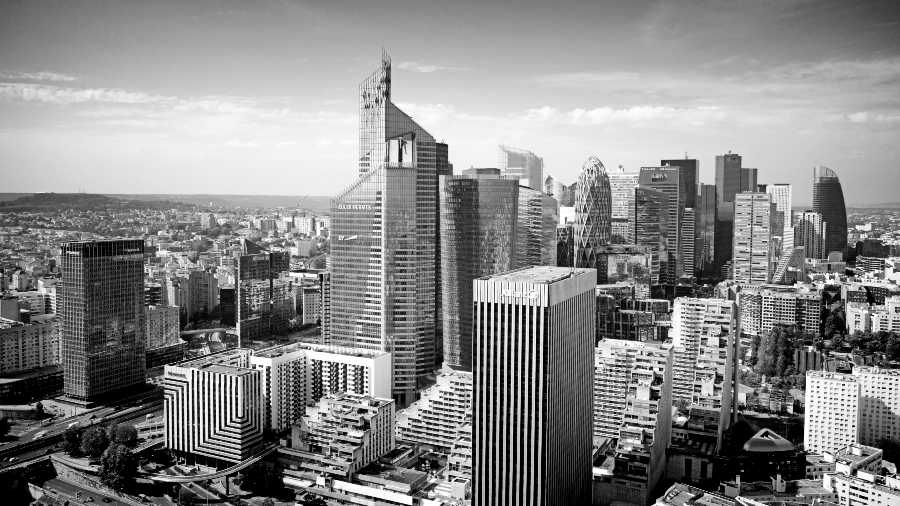In June 2020, after 80 days of complete ‘confinement’, I wrote a piece about the “Coronavirus Time Machine”. Inspired by too much lockdown Netflix, the imaginary construct was that the unique pandemic moment could either rewind or fast forward time, throwing out winners and losers at an uncomfortable velocity and accelerating trends which would otherwise have taken a generation to move.
18 months later, as we are now finally stepping out of that imaginary Time Machine journey, those winners and losers are becoming clearer in the real world. The Paris business district of La Défense has certainly not proved a property winner. Even pre-pandemic, La Défense was already showing its age – especially when measured against a peer group of similar large-scale business districts in New York, London, Singapore and Tokyo. Post-pandemic, it feels like this once-visionary district is rooted in the past and experiencing a mid-life crisis, (defined by Wikipedia as “a transition of identity and self-confidence that can occur in early middle-aged individuals”)
Conceived in the 1960’s, Paris’ vertical island of concrete, steel and glass was shaped in Pompidou’s ultra-modernist age when “the city must adapt to the car and not the reverse”. 60 years on, the high-density district is missing a sense of wellbeing created by dedicated cycle lanes or walking along a leafy waterfront. Each day, over 250,000 people go there but 180,000 of them are office workers who go home at night. Increasingly, they can also choose to go home to work.
Last week’s Urban Land Institute conference assessed the positioning of La Défense in the new post-pandemic world. We learned that public transport journeys in La Défense are back to 2019 levels but spread more evenly throughout the day. Presenters told us that the predicted mass exodus of the district’s office users has not materialised, even if the office leasing market is not healthy. The current oversupply was triggered by the simultaneous delivery of new office towers planned when a structural rethink in leasing demand was inconceivable. As this office market virus has not spread to central Paris, this is seemingly a malady specific to the timing of local oversupply and perceptions of the La Défense micro-location.
In addition to short-term infrastructure improvements by the 2024 Olympics, the ULI conference was a reminder of the many long-term ambitious projects designed to make La Défense greener, more sustainable and less “minéral”. The key question is whether these projects (such as the connection to Paris’ future ‘Plan Vélopolitain’ express cycle routes) can keep pace with rapid structural change. The creative energy of Generations Y and Z has now recognised that flexible working is a practical option. Where La Défense is largely quiet at night and at weekends, young human capital prefers living, working and playing in 24/7 city locations.
The pull for people to “work from anywhere” was a pre-existing condition, now given a name by the pandemic and given impetus by technology adoption. ULI’s conference heard that 90% of the SNCF’s 275,000 staff (!) had recently voted for more flexible working. In the longer run, “le télétravail” is a tech-driven structural trend which is here to stay – just like e-commerce.
After 18 months of webinars about the “Death of The Office”, many ULI delegates were pleasantly surprised by the recent resilience of the office sector, notably in this year’s rentrée. With structural disruptors such as le télétravail, however, it is human nature to overestimate the short-term effect but underestimate the effect in the long term. A good example is what was often known in the 1990’s as the “World Wide Web”
In the long-term, the colossal zone of La Défense simply seems too big to fail. From the public sector to users, banks and property owners, so many groups with vested interests will eventually do ‘whatever it takes’ to make the place a success. In the short-term, however, until the ambitious sustainability projects catch up with the pandemic time warp, the risk is that La Défense loses its innovative edge and becomes a location for middle-aged backroom staff.
Right now, revitalising an ageing La Défense requires more than cosmetic surgery. Mixing uses is part of that cure and some obsolete office towers will need repurposing to serve residential and educational needs, a lurch back in time to the district’s 1960’s heritage. La Défense has never been a location to do things by halves. Public and private sectors now urgently need to join forces and boldly invest in these radical anti-ageing treatments.








